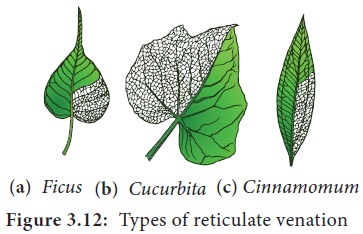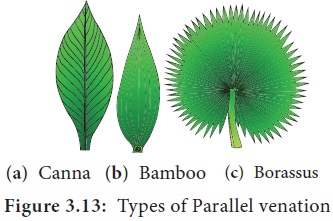Leaf | Botany - Venation and its Types | 11th Botany : Chapter 3 : Vegetative Morphology of Angiosperm
Chapter: 11th Botany : Chapter 3 : Vegetative Morphology of Angiosperm
Venation and its Types

Venation
The arrangement of veins and veinlets on the leaf
blade or lamina is called venation.
Internally, the vein contains vascular tissues. Conventionally venation is
classified into two types namely, Reticulate venation and Parallel venation.
I. Reticulate venation
In this type of venation leaf contain a prominent
midrib from which several secondary veins arise that branch and anastomose like
a network. This type of venation is common in all dicot leaves. It is of two
types.
1. Pinnately reticulate venation (unicostate): In this type of venation there is only one midrib in the centre which forms many lateral branches to form a network. Example: Mangifera indica, Ficus religiosa, Nerium.
2. Palmately reticulate venation (multicostate): In this type of venation there are two or more principal veins arising from a single point and they proceed outwards or upwards. The two types of palmate reticulate venation are
i.
Divergent
type: When all principal veins
originate from the base and diverge from one another towards the margin of the
leaf as in Cucurbita, Luffa, Carica papaya, etc.,
ii. Convergent: When the veins converge to the apex of the leaf, as in Indian plum (Zizyphus), bay leaf (Cinnamomum)
(a) Pinnately reticulate
(b) Palmately reticulate (Divergent)
(c) Palmately reticulate (Convergent)

Figure 3.12: Types of reticulate venation
II. Parallel venation
Veins run parallel to each other and do not form a
prominent reticulum. It is a characteristic feature of monocot leaves. It is
classified into two sub types.
1. Pinnately Parallel Venation (Unicostate)
When there is a prominent midrib in the center,
from which arise many veins perpendicularly and run parallel to each other.
Example: Musa, Zinger, Curcuma, Canna.

2. Palmate Parallel Venation (Multicostate)
In this type several veins arise from the tip of
the petiole and they all run parallel to each other and unite at the apex. It
is of two sub types.
i.
Divergent type: All principal veins originate from the base and
diverge towards the margin, the margin of the leaf as in fan palm (Borassus
flabelliformis)
ii. Convergent type: All principal veins run parallel to each other from the base of the lamina and join at the apex as in Bamboos, rice, water hyacinth.Rctcnngn"xgpcvcvkqp
(a) Pinnately parallel venation
(b) Palmately parallel(Convergent)
(c) Palmately parallel (Divergent)
Related Topics